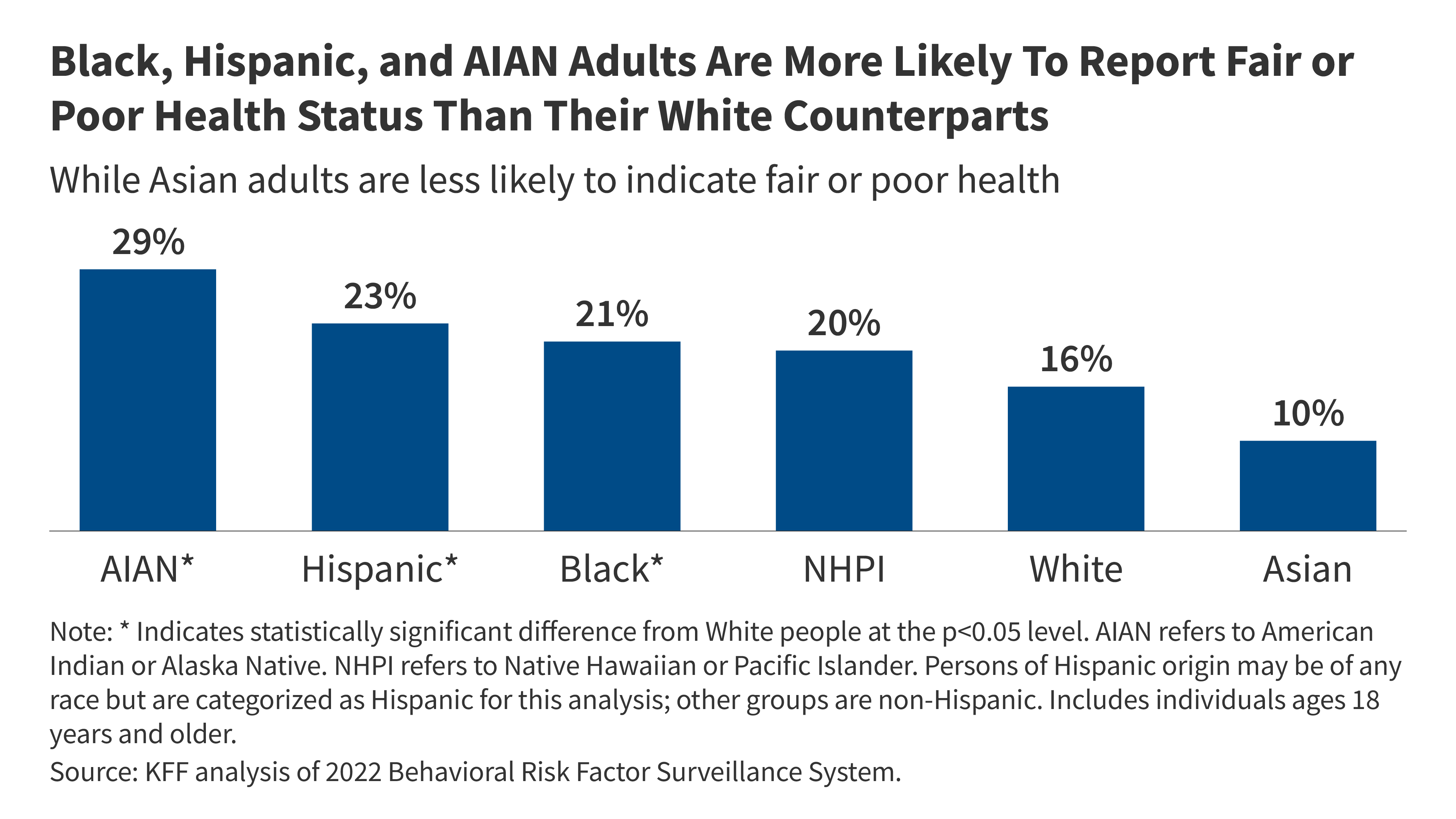Most groups of nonelderly adults of color are more likely than nonelderly White adults to report not having a usual doctor or provider and going without care. Roughly one third (36%) of Hispanic adults, one quarter of AIAN (25%) and NHPI (24%) adults, and about one in five (21%) Asian adults report not having a personal health care provider compared to 17% of White adults (Figure 7). The share of Black adults who report not having a personal health care provider is the same as their White counterparts (17% for both). In addition, Hispanic (21%), NHPI (18%), AIAN (16%), and Black (14%) adults are more likely than White adults (11%) to report not seeing a doctor in the past 12 months because of cost, while Asian adults (8%) are less likely than White adults to say they went without a doctor visit due to cost. Hispanic (32%) and AIAN (31%) adults are more likely than White adults (28%) to say they went without a routine checkup in the past year, while Asian (26%), NHPI (24%), and Black (20%) adults are less likely to report going without a checkup. Hispanic and AIAN (both 45%) and Black (40%) adults are more likely than White adults (34%) to report going without a visit to a dentist or dental clinic in the past year.
In contrast to the patterns among adults, racial and ethnic differences in access to and use of care are more mixed for children. Nearly one in ten (9%) Hispanic children lack a usual source of care when sick compared to 5% of White children, but there are no significant differences for other groups for which data are available (Figure 8). Similar shares of Hispanic (7%), Asian (7%), and Black (4%) children went without a health care visit in the past year as White children (6%). However, higher shares of Asian (23%) and Black (21%) children went without a dental visit in the past year compared to White children (17%). Data are not available for NHPI children for these measures, and data for AIAN children should be interpreted with caution due to small sample sizes and large standard errors.
Among adults with any mental illness, Black, Hispanic, and Asian adults are less likely than White adults to report receiving mental health services. Roughly half (56%) of White adults with any mental illness report receiving mental health services in the past year. (Figure 9). In contrast, about four in ten (40%) Hispanic adults and just over a third of Black (38%) and Asian (36%) adults with any mental illness report receiving mental health care in the past year. Data are not available for AIAN and NHPI adults.
Experiences across racial and ethnic groups are mixed regarding receipt of recommended cancer screenings (Figure 10). Among women ages 50-74 (the age group recommended for screening prior to updates in 2024, which lowered the starting age to 40), Black people (24%) are less likely than White people (29%) to go without a recent mammogram. In contrast, AIAN (41%) and Hispanic (35%) people are more likely than White people (29%) to go without a mammogram. Among those recommended for colorectal cancer screening, Hispanic, Asian, AIAN, NHPI, and Black people are more likely than White people to not be up to date on their screening. Increases in cancer screenings, particularly for breast, colorectal, and prostate cancers, have been identified as one of the drivers of the decline in cancer mortality over the past few decades.
Racial and ethnic differences persist in flu and childhood vaccinations (Figure 11). Roughly six in ten Hispanic (63%), AIAN (63%), and Black (58%) adults went without a flu vaccine in the 2022-2023 season compared to about half (49%) of White adults. However, among children, White children (44%) are more likely than Asian (28%) and Hispanic (39%) children to go without the flu vaccine; data are not available to assess flu vaccinations among NHPI adults and children. In 2019-2020, AIAN (42%), Black (37%), and Hispanic (33%) children were more likely than White children (28%) to have not received all recommended childhood immunizations.

